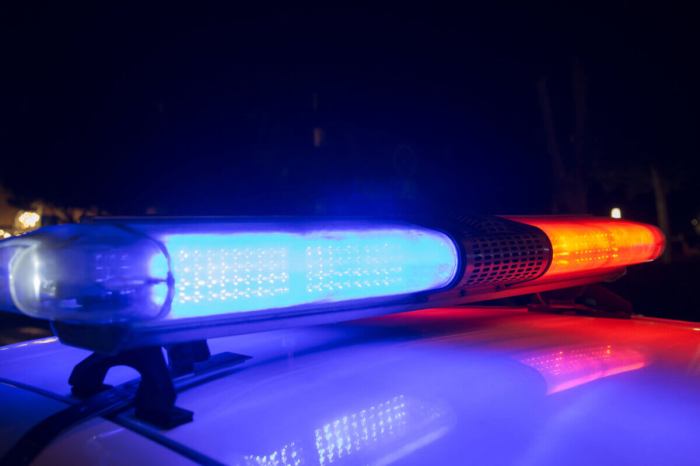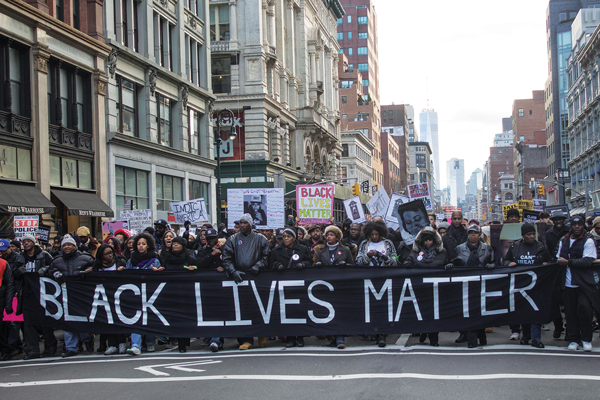
Marchers make their way through Chelsea, on Dec. 13 — here, at Sixth Ave. and W. 20th St.
BY ZACH WILLIAMS | A growing national movement against police brutality and institutionalized racism showed no signs of waning in the days following a demonstration that brought tens of thousands of people through the streets of Manhattan on Dec. 13.
Longtime activists in Chelsea say they have seen nothing like the daily protests led by young people, which have inspired an increasing number of New Yorkers to participate ever since a grand jury announced on Dec. 3 that an NYPD officer would not face criminal charges for placing a fatal chokehold on Eric Garner, an unarmed black man from Staten Island. Just eight days before, a grand jury in Ferguson, MO decided the same for the police officer who killed teenager Michael Brown.
In response, activists continue to agitate for police reforms across the country — but few places have seen protest activity as densely concentrated as that in Midtown Manhattan. Self-identified protesters, demonstrators and activists have marched through the Village, Chelsea, Hell’s Kitchen and elsewhere. They have laid down in symbolic death within Times Square, the Port Authority Bus Terminal, Penn Station, Columbus Circle, Grand Central Station and other iconic spots.
Crowds with arms up in surrender entered Macy’s at Herald Square chanting “Hands up! Don’t shoot!” and the Disney Store near Times Square. Protesters blocked traffic on the Lincoln Tunnel, West Side Highway and other thoroughfares. Honking erupted in response, often in solidarity.
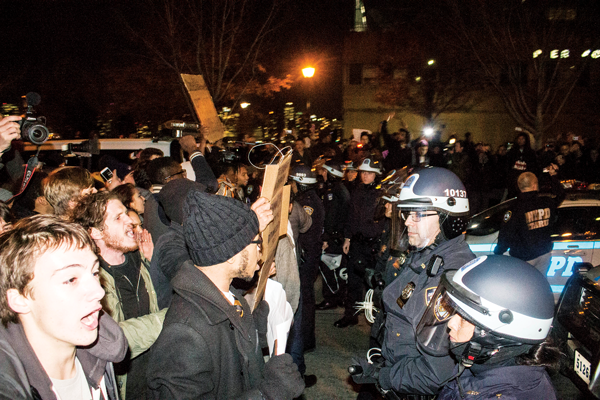
The West Side Highway, on Dec. 4. The NYPD has arrested more than 300 people over the course of recent protests.
It’s no coincidence that a great amount of such activity occurs within Midtown, according to State Senator Brad Hoylman — who took part in the Millions March NYC on Dec. 13. The confluence of tourism, culture and media at the crossroads of the world make Times Square particularly attractive for political activity, he said in a telephone interview.
“It’s a good place to get attention and these demonstrators are smart and they want their voices heard,” he added.
In years past, various protests have called for people to shut down the business of the city — but where they fell short, this new outburst of dissent continues to express longevity, according to seasoned activists.
“Many of us have been in the struggle for many, many years and we have never seen anything like it,” said Toni Arenstein, a Chelsea resident and member of Peoples Power Assemblies (peoplespowerassemblies.org) on W. 24th St.

There are also concrete demands.
They demand that the officers involved in the fatal arrest effort of Eric Garner receive punishment both through the department and a federal indictment. The federal Department of Justice and NYPD Inspector General Philip Eure should further investigate the department’s use of force against minorities. Furthermore, Gov. Andrew Cuomo should back the appointment of a state special prosecutor to investigate further, and should also oppose proposed legislation, which would make police disciplinary policies subject to contract negotiations.
And “Broken Windows” — the law enforcement philosophy that punishing small offenses will prevent violent crime — should end, according to the demands published on ThisStopsToday.org.
The organization behind the website — a coalition of activist groups — goes by the moniker #ThisStopsToday. It is also used as a hashtag on Twitter, added within a tweet as an indication of a topic. Other popular hashtags utilized by activists in recent weeks include #EricGarner, #ICantBreathe and #Ferguson.
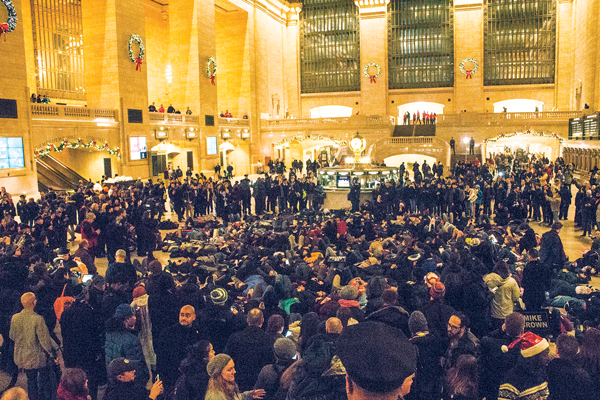
Coupled with the right meeting spot, activists can quickly rally or read the latest developments by searching the social media platform for such hashtags, as many of them did in the early evening hours of Dec. 3 following the grand jury announcement in the Garner case. That night would be the Christmas tree lighting at Rockefeller Center and activists were determined to steal the spotlight.
From Union Square, they moved north — and from Times Square, they moved east. Dozens of NYPD officers followed along each route as the two groups coalesced into a growing critical mass of about a thousand people.
Radio City Music Hall was one of many places where they tested the tolerance of New York’s finest. As in most instances throughout the protests that week and later, the rank-and-file said little in response to the chants of many and the taunts of a few, beyond “Get on the sidewalk” and “Get back.”
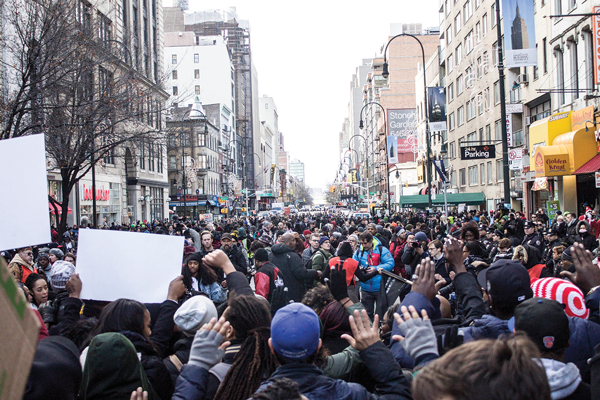
The police thwarted their effort to advance down W. 50th St. to their intended destination by gradually flanking the crowd and forcing it onto the west side of Sixth Ave. There was still a long night ahead as demonstrators gave up on the effort and moved west towards the Hudson River. Pedestrians with smart phones took snapshots as the march passed. Patrons of an Applebee’s near Times Square peered out into the streets as cable new pundits discussed the Garner case on a flat-screen television hanging in a corner.
Some among the crowd related the event to viewers via live stream video broadcasting from cameras on “selfie” sticks. Activity meanwhile erupted on social media platforms.
When protesters could take control of a street, they would move fast and against traffic to shake the NYPD. They advanced up Broadway from Times Square as far as Columbus Circle, where they staged a die-in before marching to the West Side Highway. They would snarl traffic for the next hour.
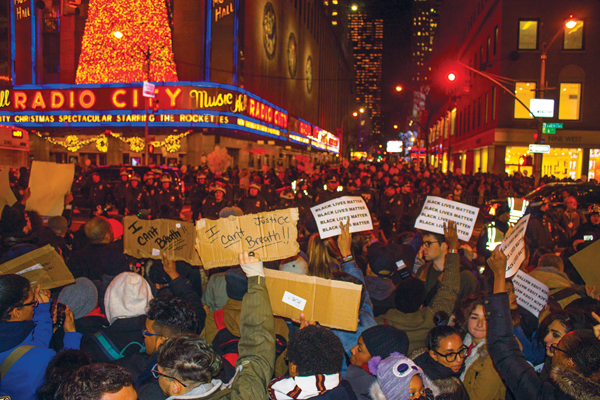
On Dec. 3, the NYPD blocked the way for protesters trying to reach Rockefeller Center (and the tree-lighting ceremony).
They would hold firm at one location with a line of police increasing pressure on them to leave. When police issued warnings that they risked arrest if they continued to block traffic, many obeyed by going on the sidewalk and traffic median, only to end up on the north side of the police line soon afterwards.
But police then shepherded others eastward onto side streets, splitting the crowd. Those north of the police then spread out as some marched towards the Upper West Side while others remained to see what happened with those who remained.
Police would recapture the initiative through such maneuvers throughout the weeks of protests.
When marchers emerged from the highway near W. 72nd St. their numbers had fallen by half — but they would continue onwards, this time southbound through Columbus Circle and Times Square again, past Penn Station, blocking traffic and staging die-ins every few blocks.
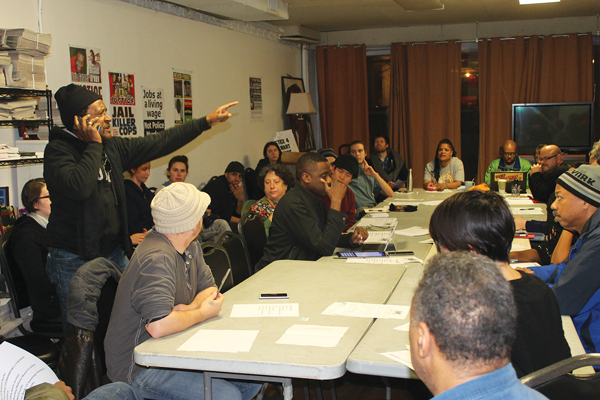
By the time they took over the eastbound lanes of the Brooklyn Bridge, only about 200 people remained with the march. The next day however, thousands more would come.
They began anew on Dec. 4, at Foley Square near City Hall. In the course of the night, thousands of protesters would roam Midtown again as well as cause temporary closures of the Lincoln Tunnel and the Brooklyn Bridge.
“It’s good to see people come together for the right reason,” said Chef Lowe of Brooklyn that night. “We’ve covered a lot of ground.”
On Dec. 5, marches and die-ins continued, and have everyday since then. They also continue to organize, both in-person and within cyberspace. About 75 activists packed the Chelsea office of Peoples Power Assemblies on Dec. 6 and Dec. 10 to discuss how the movement should evolve.
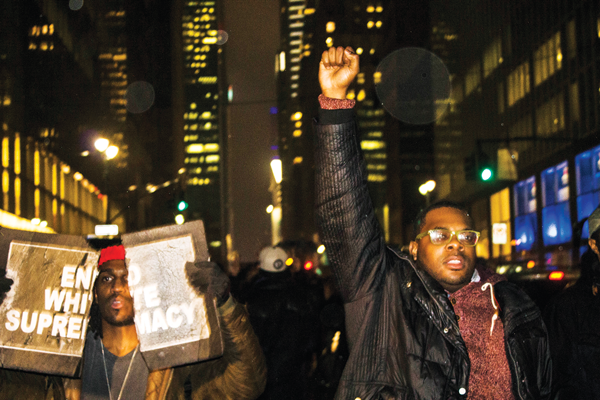
“This is one of the centers in the city for organizing these protests, but we are not the only center. Some are not even using centers. Some are just going on social media,” said Larry Holmes, a PPA organizer, at the Dec. 6 meeting.
They also discussed demands as well as a request from #ThisStopsToday for individual organizations to plan events throughout the 11 days of action occurring Dec. 10-21 in order to spread resources evenly. The length of time in the effort references the number of times that Garner said “I can’t breathe” before he died on July 17.
In forums such as these, they hash out the details of as small as who can carry signs to the next event and as large as the overall goals of their movement. Experience spreads along with suggestions to deploy more activists on roller skates or bicycles as scouts during future actions.
But even as activists continue to work together, divisions arise — particularly when it comes to the involvement of white people within the movement at, some say, the expense of people of color leading the way. Most activists insist on non-violence while some have done otherwise, notably on the Brooklyn Bridge on Dec. 13 when two NYPD officers were beaten by a small group of marchers.
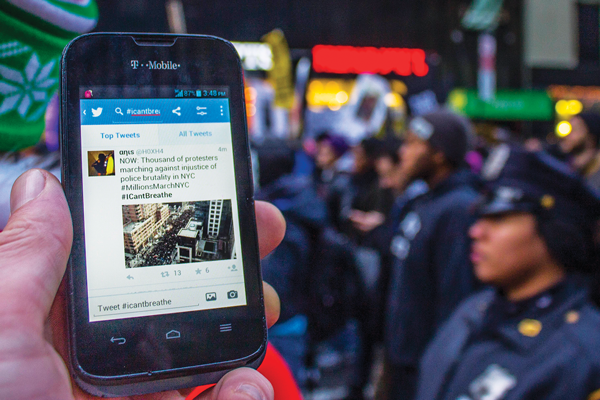
Nonetheless, activity continues to pop up in unexpected places, some inspired by individual acts of initiative. Players for the Brooklyn Nets and LeBron James donned black shirts reading “I Can’t Breathe” before a game on Dec. 9 as protesters rallied outside Barclay’s Center in Brooklyn. Just hours before, city council members staged their own die-in on the City Hall steps.
“Our country finds itself confronted with the tragic results of deep rooted bias and inequality. We are in desperate need of change, and unfortunately, New York City is no exception.” said Council Member Corey Johnson in a statement, one of about two dozen council members involved with that die-in.
As of press time, the tweets continue with four more days of planned actions in the 11-day effort, Old and young alike meanwhile continue to organize and agitate for police reform and accountability. With their social media savvy and a cause appealing to their ideals, young people are presented with a unique opportunity, according to Emma Morgan-Bennett, a student-organizer at Bard High School Early College on E. Houston St.
“We are energetic and young and can march for as long as we want and also, the most important fact is that if we don’t get off our butts and change things, this is the America we are going to have to live with,” she said.






